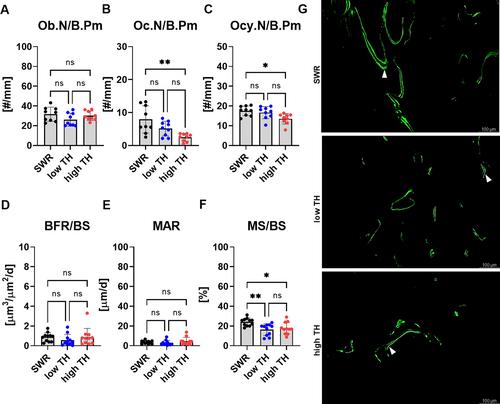Utility and Limitations of TALLYHO/JngJ as a Model for Type 2 Diabetes–Induced Bone Disease
Lejla Emini, Juliane Salbach-Hirsch, Johannes Krug, Katharina Jähn-Rickert, Björn Busse, Martina Rauner, Lorenz C. Hofbauer
{"title":"Utility and Limitations of TALLYHO/JngJ as a Model for Type 2 Diabetes–Induced Bone Disease","authors":"Lejla Emini, Juliane Salbach-Hirsch, Johannes Krug, Katharina Jähn-Rickert, Björn Busse, Martina Rauner, Lorenz C. Hofbauer","doi":"10.1002/jbm4.10843","DOIUrl":null,"url":null,"abstract":"<p>Type 2 diabetes mellitus (T2DM) increases risk of fractures due to bone microstructural and material deficits, though the mechanisms remain unclear. Preclinical models mimicking diabetic bone disease are required to further understand its pathogenesis. The TALLYHO/JngJ (TH) mouse is a polygenic model recapitulating adolescent-onset T2DM in humans. Due to incomplete penetrance of the phenotype ~25% of male TH mice never develop hyperglycemia, providing a strain-matched nondiabetic control. We performed a comprehensive characterization of the metabolic and skeletal phenotype of diabetic TH mice and compared them to either their nondiabetic TH controls or the recommended SWR/J controls to evaluate their suitability to study diabetic bone disease in humans. Compared to both controls, male TH mice with T2DM exhibited higher blood glucose levels, weight along with impaired glucose tolerance and insulin sensitivity. TH mice with/without T2DM displayed higher cortical bone parameters and lower trabecular bone parameters in the femurs and vertebrae compared to SWR/J. The mechanical properties remained unchanged for all three groups except for a low-energy failure in TH mice with T2DM only compared to SWR/J. Histomorphometry analyses only revealed higher number of osteoclasts and osteocytes for SWR/J compared to both groups of TH. Bone turnover markers procollagen type 1 N-terminal propeptide (P1NP) and tartrate-resistant acid phosphatase (TRAP) were low for both groups of TH mice compared to SWR/J. Silver nitrate staining of the femurs revealed low number of osteocyte lacunar and dendrites in TH mice with T2DM. Three-dimensional assessment showed reduced lacunar parameters in trabecular and cortical bone. Notably, osteocyte morphology changed in TH mice with T2DM compared to SWR/J. In summary, our study highlights the utility of the TH mouse to study T2DM, but not necessarily T2DM-induced bone disease, as there were no differences in bone strength and bone cell parameters between diabetic and non-diabetic TH mice. © 2023 The Authors. <i>JBMR Plus</i> published by Wiley Periodicals LLC on behalf of American Society for Bone and Mineral Research.</p>","PeriodicalId":14611,"journal":{"name":"JBMR Plus","volume":"7 12","pages":""},"PeriodicalIF":3.4000,"publicationDate":"2023-11-17","publicationTypes":"Journal Article","fieldsOfStudy":null,"isOpenAccess":false,"openAccessPdf":"https://asbmr.onlinelibrary.wiley.com/doi/epdf/10.1002/jbm4.10843","citationCount":"0","resultStr":null,"platform":"Semanticscholar","paperid":null,"PeriodicalName":"JBMR Plus","FirstCategoryId":"1085","ListUrlMain":"https://onlinelibrary.wiley.com/doi/10.1002/jbm4.10843","RegionNum":0,"RegionCategory":null,"ArticlePicture":[],"TitleCN":null,"AbstractTextCN":null,"PMCID":null,"EPubDate":"","PubModel":"","JCR":"Q2","JCRName":"ENDOCRINOLOGY & METABOLISM","Score":null,"Total":0}
引用次数: 0
Abstract
Type 2 diabetes mellitus (T2DM) increases risk of fractures due to bone microstructural and material deficits, though the mechanisms remain unclear. Preclinical models mimicking diabetic bone disease are required to further understand its pathogenesis. The TALLYHO/JngJ (TH) mouse is a polygenic model recapitulating adolescent-onset T2DM in humans. Due to incomplete penetrance of the phenotype ~25% of male TH mice never develop hyperglycemia, providing a strain-matched nondiabetic control. We performed a comprehensive characterization of the metabolic and skeletal phenotype of diabetic TH mice and compared them to either their nondiabetic TH controls or the recommended SWR/J controls to evaluate their suitability to study diabetic bone disease in humans. Compared to both controls, male TH mice with T2DM exhibited higher blood glucose levels, weight along with impaired glucose tolerance and insulin sensitivity. TH mice with/without T2DM displayed higher cortical bone parameters and lower trabecular bone parameters in the femurs and vertebrae compared to SWR/J. The mechanical properties remained unchanged for all three groups except for a low-energy failure in TH mice with T2DM only compared to SWR/J. Histomorphometry analyses only revealed higher number of osteoclasts and osteocytes for SWR/J compared to both groups of TH. Bone turnover markers procollagen type 1 N-terminal propeptide (P1NP) and tartrate-resistant acid phosphatase (TRAP) were low for both groups of TH mice compared to SWR/J. Silver nitrate staining of the femurs revealed low number of osteocyte lacunar and dendrites in TH mice with T2DM. Three-dimensional assessment showed reduced lacunar parameters in trabecular and cortical bone. Notably, osteocyte morphology changed in TH mice with T2DM compared to SWR/J. In summary, our study highlights the utility of the TH mouse to study T2DM, but not necessarily T2DM-induced bone disease, as there were no differences in bone strength and bone cell parameters between diabetic and non-diabetic TH mice. © 2023 The Authors. JBMR Plus published by Wiley Periodicals LLC on behalf of American Society for Bone and Mineral Research.

TALLYHO/JngJ 作为 2 型糖尿病诱发骨病模型的实用性和局限性
2 型糖尿病(T2DM)会因骨骼微结构和材料缺陷而增加骨折风险,但其机制仍不清楚。为进一步了解糖尿病骨病的发病机制,需要建立模拟糖尿病骨病的临床前模型。TALLYHO/JngJ(TH)小鼠是一种重现人类青春期发病的 T2DM 的多基因模型。由于表型的不完全渗透性,约有 25% 的雄性 TH 小鼠从未发生过高血糖,从而提供了一个品系匹配的非糖尿病对照。我们对糖尿病 TH 小鼠的代谢和骨骼表型进行了全面鉴定,并将其与非糖尿病 TH 对照组或推荐的 SWR/J 对照组进行了比较,以评估它们是否适合研究人类糖尿病骨病。与两个对照组相比,患有 T2DM 的雄性 TH 小鼠表现出较高的血糖水平、体重以及葡萄糖耐量和胰岛素敏感性受损。与 SWR/J 小鼠相比,患有/不患有 T2DM 的 TH 小鼠的股骨和椎骨的皮质骨参数较高,而骨小梁参数较低;与 SWR/J 小鼠相比,除了患有 T2DM 的 TH 小鼠出现低能衰竭外,其他三组小鼠的机械性能均保持不变。与SWR/J相比,两组TH小鼠的骨转换标志物1型胶原蛋白N端前肽(P1NP)和耐酒石酸磷酸酶(TRAP)都较低。硝酸银染色显示,患有T2DM的TH小鼠股骨中的骨细胞裂隙和树突数量较少。三维评估显示,骨小梁和皮质骨的裂隙参数降低。总之,我们的研究强调了TH小鼠在研究T2DM的实用性,但不一定是T2DM诱导的骨病,因为糖尿病和非糖尿病TH小鼠的骨强度和骨细胞参数没有差异。© 2023 作者。JBMR Plus 由 Wiley Periodicals LLC 代表美国骨与矿物质研究学会出版。
本文章由计算机程序翻译,如有差异,请以英文原文为准。



